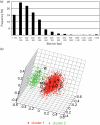From a consortium sequence to a unified sequence: the Bacillus subtilis 168 reference genome a decade later
- PMID: 19383706
- PMCID: PMC2885750
- DOI: 10.1099/mic.0.027839-0
From a consortium sequence to a unified sequence: the Bacillus subtilis 168 reference genome a decade later
Abstract
Comparative genomics is the cornerstone of identification of gene functions. The immense number of living organisms precludes experimental identification of functions except in a handful of model organisms. The bacterial domain is split into large branches, among which the Firmicutes occupy a considerable space. Bacillus subtilis has been the model of Firmicutes for decades and its genome has been a reference for more than 10 years. Sequencing the genome involved more than 30 laboratories, with different expertises, in a attempt to make the most of the experimental information that could be associated with the sequence. This had the expected drawback that the sequencing expertise was quite varied among the groups involved, especially at a time when sequencing genomes was extremely hard work. The recent development of very efficient, fast and accurate sequencing techniques, in parallel with the development of high-level annotation platforms, motivated the present resequencing work. The updated sequence has been reannotated in agreement with the UniProt protein knowledge base, keeping in perspective the split between the paleome (genes necessary for sustaining and perpetuating life) and the cenome (genes required for occupation of a niche, suggesting here that B. subtilis is an epiphyte). This should permit investigators to make reliable inferences to prepare validation experiments in a variety of domains of bacterial growth and development as well as build up accurate phylogenies.
Figures



References
Publication types
MeSH terms
Substances
LinkOut - more resources
Full Text Sources
Other Literature Sources
Molecular Biology Databases

